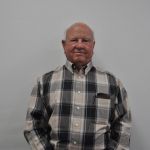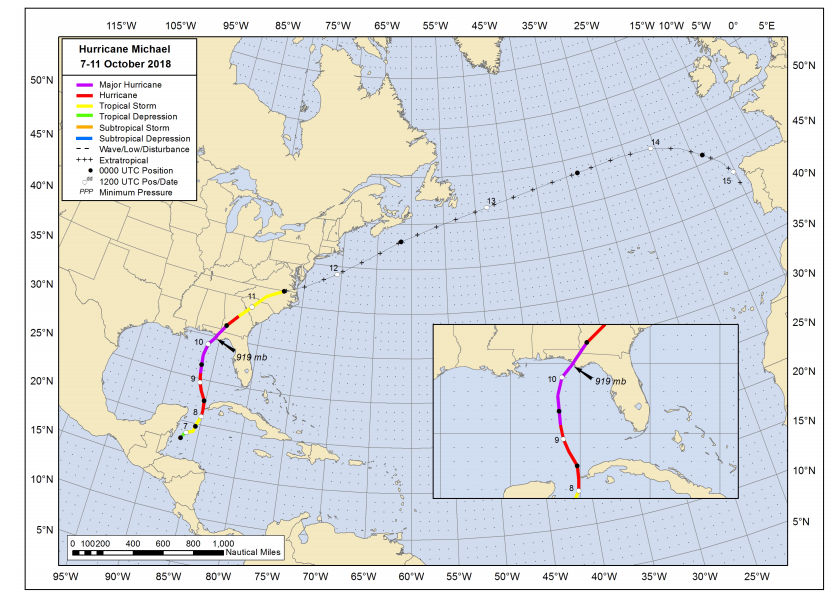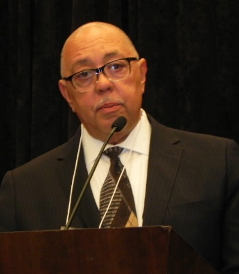
Part 1: Hurricane’s impact
In October 2018, Hurricane Michael made landfall in the Florida Panhandle as a Category 5 storm, arriving with peak winds of 155 miles per hour and leaving in its wake more than $25 billion in damages. The most impacted communities, many of them rural and with local governments administratively under-staffed relative to the rebuilding task before them, were in critical need of resources to begin the long road to recovery, many forced to rebuild from the ground up.
Representatives from FEMA’s National Disaster Recovery Support (NDRS) cadre coordinated a federal response that included partnering with college and university faculty and students to provide technical planning expertise – a model CRC has also used for recovery from 2016’s Hurricane Matthew. This is Part 1 of a story of how the ongoing work of connecting and coordinating institutions of higher education with under-resourced communities and local governments can improve long-term recovery outcomes.
“God brought us these kids,” said Gene Bailey, former chair of the Calhoun (Fla.) County Board of Commissioners. Bailey was referring to students from the University of West Florida (UWF) who came to his community in the months following Hurricane Michael to help with a major housing planning effort. Hurricane-induced flooding had caused severe damage to homes, especially those in the county’s low-lying districts.

The UWF students, supervised by their faculty mentor, were mobilized by FEMA through a program known as CUPP – College/Underserved Community Partnership Program. Run by Region 4 of the U.S. Environmental Protection Agency (EPA), CUPP connects colleges and universities with local communities to provide technical assistance in areas ranging from engineering to economics. The program was initially designed to mitigate problems of environmental degradation and social justice, but has since expanded to assist in disaster recovery.

In the case of Hurricane Michael, FEMA saw an opportunity for the CUPP program to be used to help communities in the Florida Panhandle to recover and to help rebuild them to become more resilient. After consultation with EPA’s Sustainability Advisor, who had been deployed to the disaster, and meetings with field coordinators from several other federal agencies, all agreed to explore whether CUPP could leverage its resources to aid in the recovery process. Calhoun County was especially hard hit and provided a good starting point.
“We were almost taken back to the Flintstone age on October 10, 2018, by Hurricane Michael,” said Scott Monlyn, current chair of the Calhoun County Board of Commissioners. “We were almost devastated to the point of not knowing whether we would be able to go on afterward.”
“I was newly elected, wasn’t quite sure of the way to go about putting things back together, but we came together as a board to start putting Calhoun County back together. FEMA came in and offered assistance to us, and our citizens were able to get water and tarps, and we were able to deliver goods to them. We dealt without electricity for about 23-30 days in some parts of the county.”
FEMA and Interagency Recovery

FEMA’s NDRS cadre works on recovery efforts through an interagency partnership with five other federal agencies. The U.S. Army Corps of Engineers, for example, works with the impacted state and local municipalities to restore infrastructure systems, such as roads and water resources. Teams from Housing and Urban Development work to get residents into safe living conditions. Health and Human Services addresses public health, education and social services. The Department of Interior works with the impacted state to ensure the protection and restoration of natural and cultural resources, while the Department of Commerce addresses resources necessary for economic recovery.
Dr. Olivia A. Scriven, who serves as Academia Advisor with the FEMA NDRS cadre, worked with NDRS field leadership, the EPA Sustainability Advisor and the five federal field coordinators to build out and manage projects that the communities decided were their best path to recovery. Constant communication with and involvement by Florida’s state disaster recovery coordinator, along with the local recovery groups, was critical to the process. Work with CUPP was a natural fit as the cadre looked to expand partnerships with the 40 institutions of higher education in the state’s university and college system.

A precedent of success
Hurricane Michael is not the first time FEMA’s NDRS cadre has worked with colleges and universities to support disaster recovery. That history dates to 2012, when the cadre established the Academic Recovery Team (ART) in the aftermath of Hurricane Sandy. ART worked with the New Jersey Institute of Technology’s School of Architecture to deploy students to help clear the backlog of building permits and site inspections as residents in the Highland community sought to rebuild homes and businesses which had been damaged from the 10-foot storm surge. The ART team established similar partnerships following Hurricane Matthew in North Carolina. It was in North Carolina that FEMA first connected with CUPP.

Michael Burns, creator of the CUPP program and former Senior Advisor to the Regional Administrator to EPA Region 4, said CUPP was originally contacted by FEMA in 2017 to assist the city of Princeville, NC, with flood recovery from Hurricane Matthew.
“We had an initial agreement to assist with several projects, but the local school was unable to follow through,” Burns said. “Afterwards, we developed two projects between Gregory, TX, and the University of Texas in Corpus Christi (Hurricane Harvey); the development of community resiliency plans with the University of Puerto Rico (Hurricane María); a hydrological study and storm water mitigation plans for Natchitoches, La., with Louisiana State University and the Thriving Earth Exchange (1,000 year flood event). Our goal has been to provide long-term support for these communities.”
Rick Durbrow, EPA Sustainability Advisor for Hurricane Michael, worked closely with Dr. Scriven. When Durbrow and Scriven first talked of engaging CUPP, the agreed that if they came away with three viable projects, they would consider this a metric of success. Following a week-long series of listening sessions with municipalities and recovery groups, they counted at least 70 project ideas.
“We were energized by the community response,” Dr. Scriven said.
Durbrow agrees, pointing out that the CUPP program typically works on a project-by-project basis. After Hurricane Michael struck the Panhandle, CUPP staff worked with each of the federal field coordinators to identify capacity issues across the different counties impacted by the hurricane. The federal field coordinators from the five partnering agencies then held forums with communities to determine what actions would best address their immediate concerns. Once those were in place, he said, they worked with the primary stakeholders to further refine what they would like to see supported by universities in the region and clarified how those projects addressed specific needs in the community.
The CUPP program is completely voluntary and free. Faculty integrate the projects into a course or a research project, and then mentor the students who take the lead, gaining invaluable, real-world experiences in areas ranging from architecture and engineering to community planning to complex project management.
Dr. Scriven said one of the intended outcomes of these university-community partnerships is to develop sustainable relationships, with the hope that the university and communities will continue to collaborate to build resilient communities long after FEMA demobilizes from the area.
